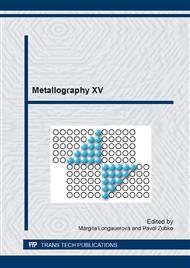p.607
p.611
p.615
p.619
p.623
p.629
p.635
p.641
p.645
Microstructural Features of Bronze-Coated Iron Coins from the Roman Empire
Abstract:
At the late second and early third century coin copies, termed subferrata, were produced in the provinces Noricum and Pannonia of the Roman Empire. Subferrata consist of an iron core, which was plated with a copper alloy. To get information about the manufacturing process and the materials used, coins were cut and investigated after metallographic preparation by light optical microscope (LOM). Scanning electron microscopy (SEM) and energy disperse X-ray analysis (EDX) were used to get information about the local chemical compositions. The general composition was determined by X-ray fluorescence analysis (RFA). The Cu alloy coatings consist of Cu, Pb, Sn, Zn and small amounts of Ag. This alloy is a variant of gunmetal, known as leaded red brass. The coatings show mainly differences in the Pb and Sn content and moreover the intermetallic phase Cu41Sn11 was found. Inside the red brass coating droplet-shaped iron inclusions were observed. Near the interface, between coating and iron core, Cu and Pb were detected at the grain boundaries (liquid metal embrittlement). Probably, the iron flan was plated by immersing in a molten copper alloy. In the ferritic-pearlitic iron core, slag inclusions and regions with various carbon contents were observed. Furthermore, deformation twins (Neumann lines) were found in the Fe core ́s microstructure, leading to the suggestion that coining was performed after cooling the flan.
Info:
Periodical:
Pages:
629-634
Citation:
Online since:
April 2014
Authors:
Price:
Сopyright:
© 2014 Trans Tech Publications Ltd. All Rights Reserved
Share:
Citation:


